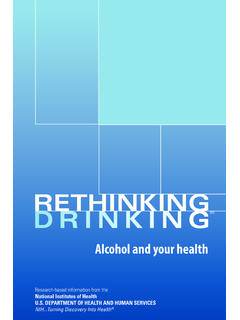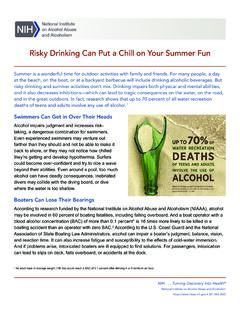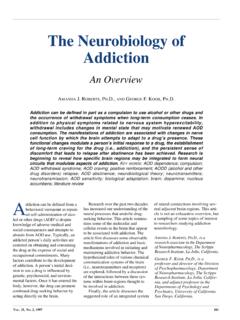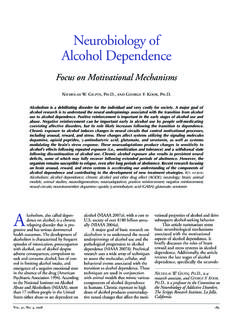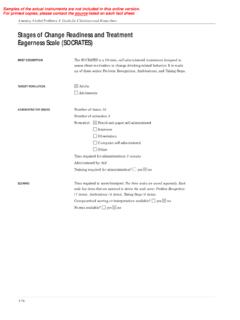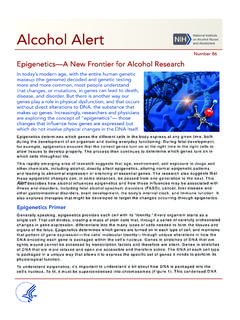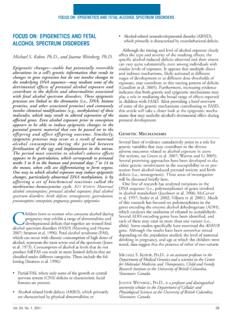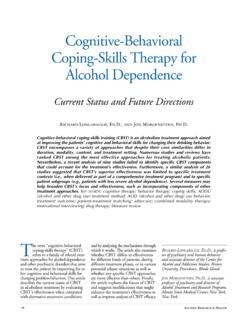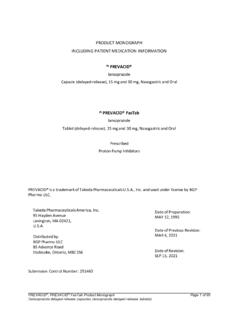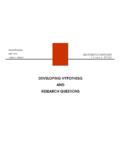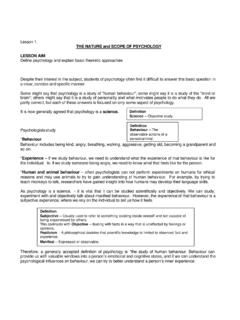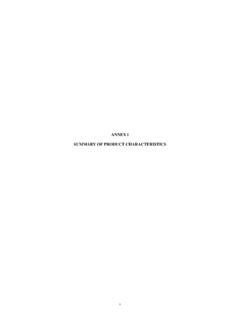Transcription of Contingency Management - National Institutes of Health
1 Contingency Management Incentives for SobrietyStephen T. Higgins, , and Nancy M. Petry, Management (CM), the systematic reinforcement of desired behaviors and thewithholding of reinforcement or punishment of undesired behaviors, is an effective strategyin the treatment of alcohol and other drug (AOD) use disorders. Animal research provides theconceptual basis for using CM in AOD abuse treatment, and human studies have demonstratedthe effectiveness of CM interventions in reducing AOD use; improving treatment attendance;and reinforcing other treatment goals, such as complying with a medication regimen orobtaining employment.
2 KEY WORDS: addiction care; treatment method; intervention;reinforcement; treatment outcome; AOD (alcohol and other drug) abstinence; problematicAOD use; multiple drug use; AOD dependence; treatment goals; treatment research; patientcompliance; employment; animal model; literature reviewContingency Management (CM)1is a strategy used in alcohol andother drug (AOD) abuse treat-ment to encourage positive behaviorchange ( , abstinence) in patients byproviding reinforcing consequences whenpatients meet treatment goals and bywithholding those consequences or pro-viding punitive measures when patientsengage in the undesired behavior ( ,drinking).
3 For example, positive conse-quences for abstinence may includereceipt of vouchers that are exchange-able for retail goods, whereas negativeconsequences for drinking may includewithholding of vouchers or an unfavor-able report to a parole officer. The rein-forcing or punishing consequences maybe contingent on objective evidence ofrecent AOD use or on another behaviorimportant in the treatment process, suchas compliance with a medication regimenor regular clinic attendance. Often,clinicians implement CM proceduresthrough written contracts that detailthe desired behavior change, durationof intervention, frequency of monitoring,and potential consequences of the patient ssuccess or failure in making the agreed-upon behavior changes.
4 An extensive body of research sup-ports CM s efficacy in treating variousbehavioral disorders, including AODabuse (Higgins and Silverman 1999;Higgins et al. 1998). This article brieflyreviews the conceptual background andempirical research demonstrating theefficacy of CM in AOD abuse and BasicScience FoundationsThe use of reinforcing and punishingconsequences to alter the form and fre-quency of voluntary behavior is knownas operant conditioning, a method thatprovides the conceptual framework forCM. Within the CM framework, AODuse is considered a form of operantbehavior that is, behavior that is main-tained in part by the reinforcing biochem-icaleffects of the abused substance andby reinforcing environmental influences( , social reinforcement from peers).
5 122 Alcohol Research & Health STEPHENT. HIGGINS, , is a profes-sor in the Departments of Psychiatry andPsychology at the University of Vermont,Burlington, Vermont. NANCYM. PETRY, , is an assistantprofessor in the Department of Psychiatryat the University of Connecticut School ofMedicine, Farmington, of this article was supportedin part by Federal grants RO1 DA09378( ), RO1 DA0-8076 ( ),R29 DA12056 ( ), and P50 AA0-3510 ( ).Vol. 23, No. 2, 1999123 Findings from animal research supportthe use of CM in the treatment of AODuse disorders. Such research demonstrates,for instance, that animals exhibit con-sumption patterns indicative of depen-dence and that researchers can modifyanimals AOD intake by using reinforcingand punishing consequences.
6 Generally,laboratory animals voluntarily ingestthe same substances that humans abuse(Griffiths et al. 1980). Rats and monkeys,for example, will voluntarily consumelarge quantities of cocaine, opioids, andalcohol. Neither a prior history of drugexposure nor physical dependence isnecessary to support ongoing and stablepatterns of AOD use in laboratory ani-mals. Moreover, studies of voluntaryAOD consumption by laboratory animalsshow that once a pattern of heavy con-sumption has been established, animalswill complete cumbersome tasks ( ,press a lever numerous times) to obtainand consume the desired , laboratory animals willforgo other reinforcers, including sweetliquids, high-calorie solutions, and insome cases even basic sustenance, toengage in AOD use (Petry and Heyman1995).
7 These behavioral patterns areanalogous to those exhibited by AOD-dependent humans, who often spendsignificant amounts of time and moneyabusing alcohol and recovering fromAOD use, and who often give up recre-ation, employment, and family activitiesto do findings that laboratory ani-mals voluntarily consume many of thesame substances that humans abuse andexhibit consumption patterns indicativeof dependence suggest that the neces-sary neurobiological systems to experi-ence AOD-induced reinforcement andto engage in compulsive AOD use arewidely represented across different , laboratory studies also indi-cate that individual and environmentalfactors clearly influence susceptibility toAOD use and abuse (Wolffgramm andHeyne 1995).
8 For example, when firstexposed to alcohol, rats bred for highalcohol intake will voluntarily consumelarger amounts of alcohol than non-selectively bred rats. However, even ini-tially low-alcohol-consuming rats willvoluntarily consume large quantities ofalcohol under certain conditions. Forexample, stress, social isolation, andreduced access to food, liquid, or oppor-tunities for exercise all promote AODuse in laboratory animals. Therefore,susceptibility to the reinforcing effectsof AODs appears to be a product ofnormal neurobiological systems commonto many species that can be heightenedby certain individual and environmen-tal from animal studies mayhave implications for human AODabuse treatment in that the environmen-tal conditions which promote AODuse in laboratory animals seem similarto those associated with excessive AODuse in humans (Griffiths et al.)
9 1980).Animal studies also demonstrate thatconditions can be altered to reduce AODuse even after high levels of use havebeen established. Such studies suggestthat an increase in both the availabilityof alternative, nondrug sources of rein-forcement and the direct and indirectlosses associated with AOD use arerelated to decreased AOD use (Higgins1996). For example, providing food,liquids, or novel environmental alterna-tives reduces AOD use in animals, justas providing entertainment or financialalternatives reduces AOD use in , as previously noted, animalsand humans will work hard or forgoother reinforcers to consume addictivesubstances, an increase in the availabilityof alternative reinforcers will decreaseAOD consumption.
10 Furthermore,increasing the demands required to obtainthe desired substance ( , increasingthe number of times an animal mustpress a lever to obtain the alcohol) ordirectly associating substance use withthe loss of other desired goods ( ,withholding vouchers as a consequenceof alcohol use) reduces AOD use aswell (Higgins 1996).CM interventions are based on theview that AOD use is a behavior that is influenced by neurobiological andenvironmental factors and that suchbehavior can be changed by applyingconsistent environmental consequencesto reinforce the targeted behavior following sections of this articledescribe research on the application ofCM in the treatment of alcoholism andproblem drinking as well as of otherdrug use Research andApplication of CM in the Treatment ofProblem DrinkingResearch during the 1960s, 1970s.
